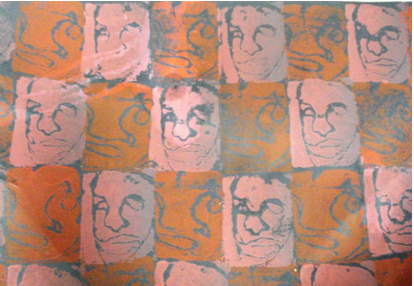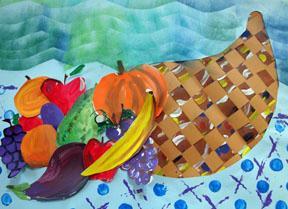Painting Pictures in Motion

Target Group: Grades 5-6
Goal (Terminal Objective): Students will create artwork to communicate ideas.
Objectives:
1. Students will examine Jacob Lawrence’s thematic “Builders” paintings to discover how he communicated his hope that people could work together to build a better world with this lesson from Sargent Art.
2. Students will paint a figure in motion to communicate an important idea about work, play, or study.
National Standards:
Visual Arts Grades K-8 Content Standard 1: Understanding and applying media, techniques, and processes
Visual Arts Grades K-8 Content Standard 2: Using knowledge of structures and functions
Visual Arts Grades K-8 Content Standard 3: Choosing and evaluating a range of subject matter, symbols, and ideas
Visual Arts Grades K-8 Content Standard 5: Reflecting upon and assessing the characteristics and merits of their work and the work of others
Purpose: Students will use critical thinking skills as they develop visual images that function as metaphors for bigger ideas.
New Vocabulary: theme, metaphor, diagonal, motion
Materials:
- Sargent Art Tempera Paints 16 oz. (#22-54xx)
- Sargent Art Metallic Tempera Paints 8 oz. (#22-50xx)
- Sargent Art Classic Fine Tip Markers (#22-1540) - for details, if desired
- Sargent Art 5 Ct. Quality Brush Set per student (#56-6000)
- Heavy 12x18-inch paper for painting
- Pencils/erasers for sketching
- One 6-, 11-, and 15-inch piece of thick yarn per student
- One 2 1/4 x 2 3/4 inch egg-shaped oval per student
Time: 4-5 50-minute class periods
Introduction and Motivation (Set):
The teacher shows pictures of students playing team sports. Students respond to the questions “Why is it important for these teammates to practice together? Why is it a good idea for these students to study together?” After discussing student responses, the teacher shows a selection of Lawrence’s “Builder” themed paintings. The teacher explains Lawrence painted builders again and again throughout his career. These builders were metaphors for people who were building a better life for themselves and their families. The teacher helps students make a connection between Lawrence’s images of builders standing for building a better life and the possible interpretations for images of students working or practicing together.
Instruction:
Day 1: The teacher demonstrates how to use the three pieces of yarn to construct a two-dimensional manikin and instructs students to pose the manikin on their papers. The teacher directs students to align manikins on a diagonal to suggest movement and try several poses that suggest working, playing, and studying. Teacher redirects students’ attention to a “Builders” print to remind students Lawrence used angular lines to render shapes and diagonals to show movement. After students have their manikins in satisfactory positions, the teacher demonstrates how to draw around the yarn manikins to suggest a figure with muscles. Teacher directs students to sketch figures and add a simple background.
Day 2: Teacher reviews Lawrence’s “Builder” themed paintings and directs students to complete background sketch. Teacher demonstrates appropriate sequence for painting and models correct brush handling techniques. Students paint backgrounds. Teacher circulates around the room to check for understanding. At the end of the session, the teacher asks students “What might be some of the ways you showed your figure was moving?”
Day 3: Teacher reviews Lawrence’s “Builder” themed paintings and directs students to write a title for their painting on the back of their paper. The teacher directs students to begin thinking about what might be possible interpretations of their paintings. Students continue to paint while the teacher circulates. At the end of the session, the teacher asks students “How might your painting be similar to those painted by Lawrence?” and “How might a figure studying be a metaphor (stand for) for a bigger idea?” and “How might a figure playing a sport be a metaphor for a bigger idea?”
Day 4: Students complete paintings. At the end of the session, the teacher asks students to respond to the three prompts listed in the Evaluation Section.
Activities:
(1) Guided Practice: The teacher models the use of the manikin and students practice posing the manikins to suggest working, playing, and studying.
(2) Independent Practice and Check for Understanding: Students sketch and paint figures and backgrounds. Formative assessment occurs three times during the painting lesson. The teacher assesses student understanding of the builder metaphor used by Lawrence during the introductory set. The teacher assesses students’ ability to construct and pose the manikin while circulating through the classroom. The teacher assesses students’ ability to use appropriate painting technique while circulating through the classroom.
(3) Closure: Closure occurs at the end of each of the 4-5 days of instruction in the form of a walk away question.
Evaluation: In the summative assessment, students respond in written form to the prompts:
a. List three ways your painting is similar to those of Jacob Lawrence.
b. Describe what your figure is doing.
c. Jacob Lawrence used figures in the “Builders” paintings to stand for his hope that people could work together to build a better world. What might the figure in your painting stand for?
Extensions: Lawrence was known for his ability to paint historical narratives in multi-paneled series. His visual stories of African-American heroes such as Frederick Douglass and Harriet Tubman will provide students with insights on the struggle against slavery that will make history come alive.












